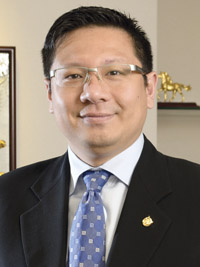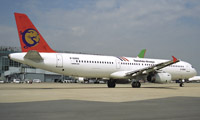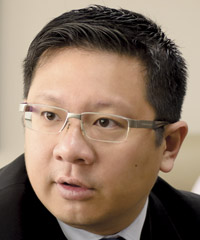Cover Story
April 1st 2012
At 38, and after just 18 months as chairman, Vincent Lin has worked wonders for Taiwan’s TransAsia Airways
INSPIRATIONAL Read More »
 |
| 'If every person in China made one visit to Taiwan in their lifetime, the airlines would have full loads for the next 20 years' |
| Vincent Lin Chairman TransAsia Airways |
TransAsia Airways’ 38-year-old chairman, Vincent Lin, says he has a lot to learn about the airline industry.
It’s not surprising. He only took the helm a little over 18 months ago and prior to that was working for the parent company’s security division. But in a market dominated by international carriers, China Airlines and EVA Air, he has turned a struggling regional carrier into a thriving listed company.
The carrier was exiting what the chairman called “a slump” when he joined in 2010. “We had gone through a number of tough years,” he said. But in that first year TransAsia recorded a US$30 million net profit. He repeated that success in 2011. Last month, the carrier announced a $22.5 million net profit for the year.
Last November, TransAsia listed on the Taiwan Stock Exchange and last month revealed it was to issue up to 50 million shares through private placement to international strategic investors to fund its international expansion.
Having tasted early success, the dynamic and very hands on Lin now has ambitions to close the gap on its ‘big brother’ rivals. “But slowly,” he said, urging caution. Maintaining profitability was critical before aggressive expansion, he added.
TransAsia has a fleet of 18 aircraft (nine A320/321s and nine ATR72-500s), but will more than double that figure with the addition of 20 Airbuses on order and options in the next five years (two A330-200s, six A321-200s, six A321neos with six options) and nine ATR72-600s. It operates 38 scheduled routes throughout Asia, including China, Japan, South Korea, Singapore, Vietnam and Macau.
A major factor in TransAsia’s recent success has been the opening of cross strait flights between Taiwan and China. Indeed, last year 31% of its revenue came from its Mainland operations.
But Lin is keen to point out that TransAsia’s goals extend way beyond China. In five years – “as long as government policy permits” says the chairman – TransAsia hopes to fly to all major Asia-Pacific cities within a nine-hour radius of Taiwan. This would amount to three or four new major routes a year and would include destinations in Australia, New Zealand and the Middle East.
If TransAsia reaches these goals, the airline would achieve a not-so-slow expansion of 20% a year, according to Lin, who was a U.S. trained lawyer before joining the family business.
Lin believes government policy in the last 20 years has held back progress in Taiwan’s aviation industry. While other countries have been opening their skies Taiwan has adopted a closed door policy. This has meant that Taiwan has fallen behind major hubs like Singapore and Hong Kong.
 |
| TransAsia Airways: to more than double its fleet in five years |
Lin pointed to outdated regulations that dictate an international route cannot be shared by more than two airlines, as an example. Invariably, China Airlines and EVA Air have been the beneficiaries of such policy.
The government of Ma Ying-jeou is keen to promote Taipei’s Taoyuan International Airport as a hub and boost tourism, particularly across the Taiwan Strait. TransAsia’s chairman wants to see that sooner rather than later and has been lobbying hard for change since he started in the job.
What’s more he has been successful. Last June, TransAsia became the third Taiwanese carrier to be allowed to operate to Singapore. More recently, Taiwan and Japan have signed an open skies agreement and TransAsia is in the process of converting charter flights into scheduled operations. It has applied for scheduled flights to Osaka, Sapporo, Hakodate, Asahikawa, Fukuoka and Okinawa this year.
Around 2.11 million tourists travelled between Taiwan and Japan in 2011. This is expected to grow at 10% a year following the open skies deal.
Lin is looking to continue to break down the barriers with Taiwan’s major carriers by joining them with services to cities like Bangkok, Hong Kong, Kuala Lumpur and cities in Indonesia in the not-too-distant future.
While Lin and his 1,200 staff are building up the regional network, there is no denying where the cash cow is – Mainland China. And it can only get bigger and better as travel restrictions are relaxed between the two sides.
TransAsia celebrated its 60th anniversary last year, but the TransAsia of today was formulated in the 1980s when parent Goldsun took over the management of operations under the direction of Lin’s grandfather and uncle. Today, his father heads the parent company.
 |
| TransAsia Airways chairman, Vincent Lin: ‘We are learning how to compete’ |
For about five years it was no more than a big general sales agent, as the group positioned the carrier in readiness for cross strait flights. “We resumed domestic flights in 1988 with our ATRs, but of course it took another 20 years for cross strait flights to happen,” said Lin.
The intervening years were tough for the airline. Although A320s and A321s entered the fleet in the early 1990s and regional charter flights were launched to Indonesia and Macau, the once thriving domestic market began to nosedive as manufacturers moved their factories from Taiwan to Mainland China.
The final nail in the coffin for Taiwan’s domestic aviation market was the opening of the high speed rail link between Taipei and Kaohsiung.
But direct flights breathed new life into airlines in both Taiwan and China when they started in 2009, initially with special Chinese New Year flights. In 2010, the green light was given to scheduled flights. Today, in addition to group tours, a percentage of individual Mainland travellers are allowed to make the trip across the Taiwan Strait.
TransAsia flies to 13 cities in China. It will add four more to its network during 2012. In the first nine months of 2011, 31% of its revenue was from China flights, 4% up on the whole of 2010. This is compared with 29% of its revenue from regional flights to September last year (4% up on 2010), 25% from domestic services, 8% from charter flights and 2% from cargo.
What is even more telling is that after carrying 90,000 passengers between Taiwan and China in 2010, TransAsia increased this figure more than five-fold last year to 500,000 passengers.
Loads on the cross strait services averaged between 80%-85%. “We are just scratching the surface,” said Lin. “It’s said that if every person in China made one visit to Taiwan in their lifetime, the airlines would have full loads for the next 20 years.
“If the flights had been introduced four or five years earlier, it would have also been a very different position. We missed an opportunity.
“In 2010-2011, a lot of the slots at China’s major airports were taken up by foreign carriers and the Mainland’s domestic market. We are now adding routes to secondary cities, but as long as the economy continues to grow in these cities, our traffic will increase.
| TransAsia at a glance |
| * TransAsia was launched 60 years ago and was Taiwan’s first private domestic carrier. * Today, it is part of the Goldsun Development Group of which Vincent Lin’s father is chairman. The parent company also has interests in the security, cement and catering industries and owns a travel agency. * TransAsia was listed on the Taiwan Stock Exchange in November 2011. * It has a fleet of 18 aircraft, nine A320/321s and nine ATR72-500s. It has 20 Airbus on order and options (two A330-200s, six A321-200s, six A321neos with six options). * The carrier operates 38 scheduled routes throughout Asia, including China, Japan, South Korea, Singapore, Vietnam and Macau. * Staff – 1,200 |
“If everything goes to the grand plan maybe all restrictions on Mainland travel will be lifted in the next couple of years.”
Looking to the future Lin said: “We will be very prudent in our decision-making about how we grow our fleet and do our route planning. Profitability is still our number one concern. We will not put the airline at risk by being over aggressive,” he said. “But we believe we can compete at any level.”
Lin said TransAsia was eventually looking to expand its small cargo business. “The market is cyclical and the cargo business will improve. We have to decide whether we want to stick to belly load cargo, launch a separate unit or maybe go for a niche market,” he said.
TransAsia is to develop a training centre for pilots and cabin crew. Lin said the airline could face a pilot shortage and steps were being taken to deal with it. “We are working with Airbus to see what the alternatives are. I believe we will be OK for the next three or four years. We do not have expatriate pilots at the moment, but that could be an option as a last resort,” said Lin.
The airline may also build a maintenance, repair and overhaul facility at one of Taiwan’s airports. Currently, it maintains its ATR fleet, but the Airbus fleet is outsourced for servicing.
Lin admitted he is not an out and out airline man like some of his peers. “I am interested in all the companies within our group. Aviation in particular? Yes, I am enjoying running the airline,” he said.
“Has it always been a dream of mine to be chairman of the airline? Honestly speaking, I did not think of it until I was offered the position,” he said.
But the chairman is a close observer of the industry and “takes different things from different airlines”. “I saw Virgin Atlantic as an airline that was prepared to take on the big boys like British Airways. They are giantkillers. We are not quite giantkillers yet, but we are learning how to compete,” said Lin.
“In terms of service quality and reputation Singapore Airlines is second to none. I admire what they have done. The growth of the Middle Eastern airlines inspires me. It shows what can be done and without joining an alliance.
“This is something we have thought about. Maybe it’s a question of timing. If we were invited to join an alliance we would be happy to participate, but before that we would like to develop relationships with as many carriers as possible on our own terms.
“The truth of the matter is that you can survive without an alliance.”
The youthful Lin is frank and refreshingly open about his lack of experience in the aviation business. But if the last 18 months are anything to go by, he is a quick learner. The future of TransAsia and its 1,200 staff appear to be in good hands.